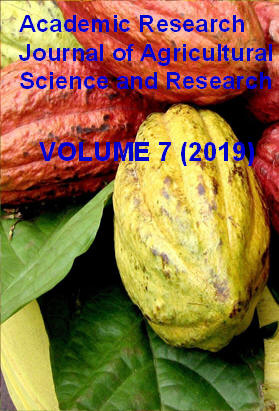|
ISSN: 2360-7874 |
Academic Research Journal of
Agricultural Science and Research |
|||||||||||||||||||
|
Vol. 7(6), pp. 319-325, September 2019 Research Herbage yield and Bio-chemical traits as influenced by harvesting age of lemongrass (Cymbopogon citratus (DC) Stapf) varieties at Wondogenet, South Ethiopia
Wondu Bekele1* Meseret Tesema2 *, Kasa Mammo1*, Hussien Mohammed2*
1* Department of Horticulture; Ethiopian Institute of Agricultural Research 2* School of plant and horticulturalsciences, Hawassa University Corresponding Author: Wondu Bekele,E-mail: askwon1984@gmail.com
Accepted 9 June 2019
Lemongrass, a perennial herb widely cultivated in the tropics and subtropics, designates two different species, East Indian, Cymbopogon flexuosus DC (Stapf). and West Indian, Cymbopogon citratus DC (Stapf).This study was carried out on lemongrass (Cymbopogon citratus DC (Stapf)), one of the members of the family Poaceae. The oil of this aromatic herb is one of the most important essential oils. Lemon grass has high citral content (75-85percent), the oil possesses a strong lemon odor. The studies conducted from August 2015 to January 2016 were aimed to assess the effect of harvesting age of lemongrass varieties on agronomic, herbage yield, essential oil content. Planting material was prepared by dividing well grown clumps into slips. The study consisted two varieties of lemongrass: Lomisar-I and WG-Lomisar-UA and four harvesting age: 105(H1), 135(H2), 165(H3) and 195(H4) days after planting (DAP)were factorials arranged in randomized complete block design(RCBD) with three replications. The herbage yield and essential oil content were determined. The result shows fresh herbage per hectare was in the interaction between variety WG-lomisar-UA and harvesting age at 135 days after planting which was higher by 84% from early harvesting at 105 dates after planting. The highest dry herbage per hectare was obtained when WG-lomisar-UA harvested at 195 DAP. Thus, dry herbage yield higher by 73% from early harvested at 105 days after planting. The highest mean essential oil content was in the interaction between variety lomisar-I, harvested at 195 days after planting. Based on this result, the highest fresh herbage yield obtained when variety WG-lomisar-UA harvested at 135 DAP. The highest essential oil content was obtained from Lomisar-I variety (0.60%); while the lowest was obtained for WG-Lomisar-UA variety (0.47 %).Variety Lomisar-I is better and can be selected for the production of essential oil than WG-Lomisar UA. The best age of harvesting for essential oil production is 195 DAP.
Key word; lemongrass; harvesting age; essential oil
How to cite this article (APA Style): Wondu B., Meseret T., Kasa M., Hussien M. (2019). Herbage yield and Bio-chemical traits as influenced by harvesting age of lemongrass (Cymbopogon citratus (DC) Stapf) varieties at Wondogenet, South Ethiopia. Acad. Res. J. Agri. Sci. Res. 7(6): 319-325
|
|||||||||||||||||||
